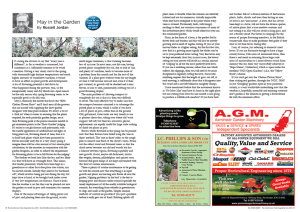
It’s stating the obvious to say that “every year is different”, as far as weather is concerned, but sometimes it is sufficiently extreme to be worth a mention. Having a very sunny start to the spring, with abnormally high daytime temperatures and much higher amounts of cumulative sunshine, is bound to have an effect on plant growth and development. A lot of flowering potential is laid down by what happened during the previous year, so the exceptionally sunny and dry March into April cannot be the only reason why spring flowering seems to be especially good so far this year.
May is, famously, the month that hosts the “RHS Chelsea Flower Show” and I don’t envy all the growers that are trusted with supplying the show garden designers with their plant material. It’s always a bit of a ‘dark art’ when it comes to ensuring that the plants required, for each particular garden design, are at their flowering peak at the precise moment needed to get maximum points in the ‘Show Garden’ judging. It’s easier to use glasshouses and polytunnels, with the careful application of artificial heat and light, to bring plants on, flowering ahead of time, than it is to hold back plants which have been promoted to flower unusually early due to a very sunny spring. I imagine there will be a fair amount of last minute plant substitution, by the nurseries in conjunction with the garden designers, in order to achieve the requirement for flowering plants to be in full flower for the judging!
The further we head into May the less and less likely it is that we’ll have an overnight frost. This means that tender perennials, which have been kept in a greenhouse or other frost-free place over winter, can be moved outside. Initially they need to be ‘hardened off’, which involves being put out during the day, but kept close at hand, to be brought back under cover if very low temperatures are forecast. Once it looks like the weather is set fair they can be planted out into the garden or used in pots and containers for summer displays.
One of the major advantages of taking plants out of pots and planting them into the ground, or into much larger containers, is that watering becomes less of an issue. In most years, not this one, having potted plants completely dry out, due to lack of rain and plenty of sunshine, tends to become more of a problem from this month and for the rest of the summer. If a plant goes without water for any length of time it will become stressed and, even if it then gets watered, its growth will be checked and it may flower, or run to seed, prematurely, robbing you of a good flowering display.
The main problem of allowing compost to completely dry out is that it is then very difficult to rewet. The only effective way to make sure that the compost becomes saturated is to submerge the potted plant in water, which is tricky if you have a lot of plants in pots, rather than in the ground. Old, galvanised, water tanks are very trendy to use as planters these days, taking over where old ‘wash coppers’ left off, but their less attractive, plastic, replacements are equally useful for large scale soaking of dried out plants in pots.
Shrubs which flowered in the spring can be pruned now that their flowers have faded using the ‘one in three’ method. The ‘one in three’ refers to the rough plan to remove one third of the shrub’s stems. Prune out the oldest wood and flowered stems so that the shrub never becomes too old and woody but has a balance between vigour, flowering capability and new growth. Good, maybe old-fashioned, shrubs like weigela, deutzia, philadelphus and spiraea soon become dull great lumps if not kept rejuvenated with this kind of routine maintenance.
There is plenty of routine maintenance to be getting on with this month now that everything is in rapid growth and plants are bursting into flower all over the garden. Nipping problems ‘in the bud’ is the key to keeping pests and diseases under control especially the timely deployment of all the readily available biological controls, for everything from whitefly in greenhouses to slugs and snails in the garden. Simple, manual, methods of control are possible if you spot a problem before it really gets out of hand. Rubbing aphids off plant stems is feasible when the colonies are relatively isolated and not too numerous; virtually impossible when they have multiplied to the point where every stem is covered. Fortunately, birds, with hungry nestlings to feed, are voracious consumers of many of the invertebrate pests which would otherwise over-run the ornamental garden.
Grass, in the form of a lawn, is the perfect foil to flower beds and borders and this will also be actively growing and in need of regular cutting. If you set your mower blades to a higher setting, for the first few cuts, now that it is growing more rapidly the blades can be set to your preferred lower setting. Very fine lawns may be kept extremely short but, in most cases, the lowest setting on your mower will result in a certain amount of ‘scalping’ in all but the most perfectly level lawn. If you use a mulching mower, rather than one which collects the clippings, then you will need to be more disciplined in regularly cutting the lawn. Successful mulching requires that the length of grass cut off, at each mowing, is sufficiently short that it disappears into the sward and is not left behind in unsightly clumps.
I have mentioned before that the movement known as ‘No Mow May’ may have its heart in the right place but not cutting your lawn for one month is not going to produce a wildlife-rich meadow! If you have beds and borders full of a diverse mixture of herbaceous plants, bulbs, shrubs and trees then having an area of lawn is not ‘anti-nature’. A lawn, that has always been kept as a lawn, will not have the diverse species of native plants that a true meadow contains and not cutting it in May will just result in long grass and not a flowery mead. Far better to campaign for the return of proper flowering meadows, to the British countryside, than to make gardeners feel guilty if they dare to cut their lawns during May.
I am, of course, just referring to domestic sized lawns. If you are fortunate enough to have a large country house, with acres of manicured lawns, then there is real merit in returning those large scale areas of monoculture to a more diverse sward; from memory this has been very successfully achieved at ‘Slape Manor’, Netherbury, which is open under the excellent ‘NGS Open Gardens’ (a.k.a. the ‘Yellow Book’) scheme.
If you can’t get into the ‘Chelsea Flower Show’, then visiting real gardens, through the ‘NGS’, ‘RHS’ or just ‘Googling’ gardens open in your particular vicinity, is a very worthwhile undertaking now that the weather is, hopefully, amenable and enjoying someone else’s garden is the ultimate in getting a horticultural fix with the minimum effort.



